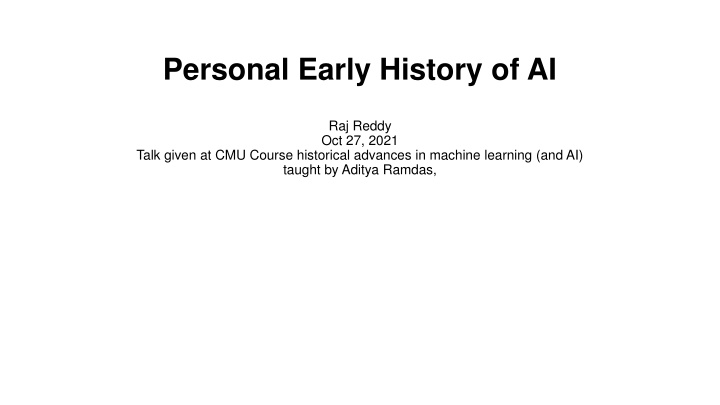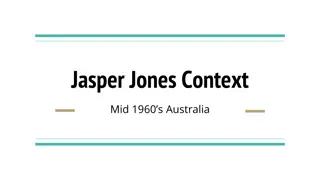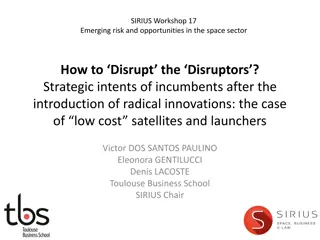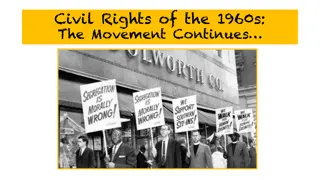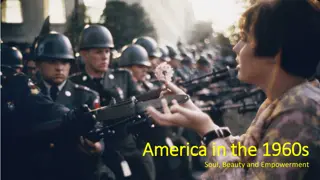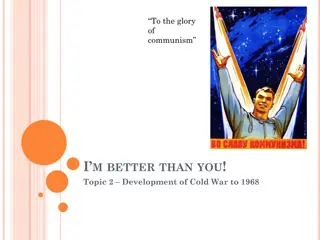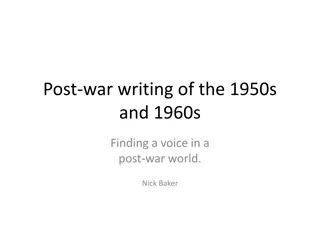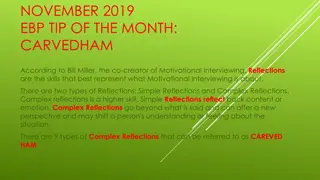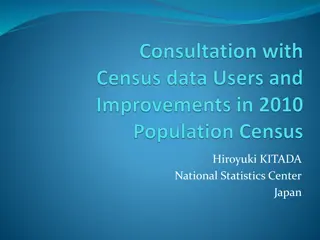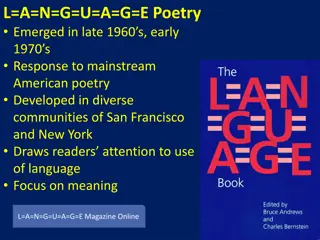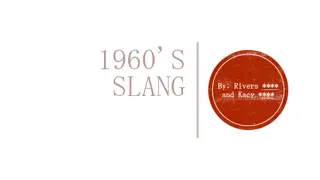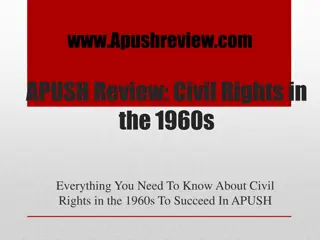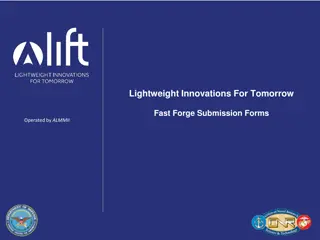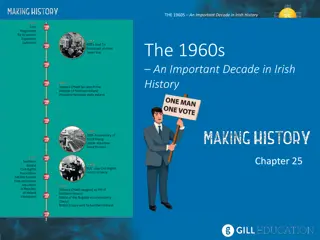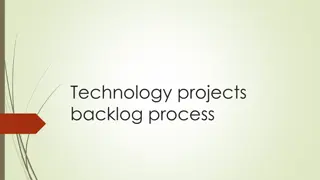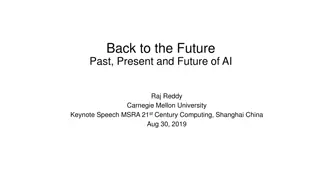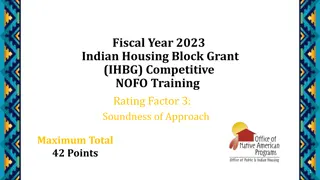Early History of AI: Reflections on 1960s Innovations and Projects
Explore the early history of AI through reflections on the advancements and projects from the 1960s. Delve into key developments in robotics, computer vision, knowledge engineering, speech and language understanding, and more. Learn about pioneering initiatives like The Hand Eye Project, Image Analysis and Understanding, Mobile Robotics, and Expertise Heuristic Dendral that laid the foundation for the AI landscape we see today.
Download Presentation

Please find below an Image/Link to download the presentation.
The content on the website is provided AS IS for your information and personal use only. It may not be sold, licensed, or shared on other websites without obtaining consent from the author.If you encounter any issues during the download, it is possible that the publisher has removed the file from their server.
You are allowed to download the files provided on this website for personal or commercial use, subject to the condition that they are used lawfully. All files are the property of their respective owners.
The content on the website is provided AS IS for your information and personal use only. It may not be sold, licensed, or shared on other websites without obtaining consent from the author.
E N D
Presentation Transcript
Personal Early History of AI Raj Reddy Oct 27, 2021 Talk given at CMU Course historical advances in machine learning (and AI) taught by Aditya Ramdas,
Reflections on Reflections on Early AI and CS at Stanford Early AI and CS at Stanford 1963 1963 1969 and Beyond 1969 and Beyond Raj Reddy Carnegie Mellon University March 21, 2006 Panel at CS40 celebrations
1960s: The Golden Age of SAIL Robotics Computer Vision Knowledge Engineering Speech Language Understanding Computer Music Chess, Symbolic Mathematics, Correctness of Programs, Theorem Proving, Logical AI, Common Sense Time Sharing LISP DEC Clones: Foonly, Graphical Editors, Pieces of Glass, Theory of Computation
The Hand Eye Project Interaction with the Physical World Early work by Karl Pingle, Bill Wichman, Don Pieper Main Project Team Jerry Feldman, R. Lou Paul, Marty Tenenbaum, Gerry Agin, Irwin Sobel, etc. Robotic Hands Bernie Roth and Vic Scheinman Started in 1965 Using the PDP1 and later the PDP6 Led Machine Vision and Robotics Industry Via SRI and Vic Scheinman
Image Analysis and Understanding Image Analysis Manfred Hueckel, Ruzena Bajcsy, and Tom Binford Led to Vision and Robotics at UPenn Image Understanding Natural Scenes and Face Recognition Mike Kelly and Raj Reddy Led to Vision and Robotics at CMU
Mobile Robotics Mars Rover and Stanford Cart Marvin Minsky (visiting) Mars Explorer project 1964 Les Earnest Bruce Baumgart Lynn Quam Hans Moravec Rod Brooks (later in the seventies) Influenced direction of programs at SRI and MIT
Capturing Expertise Heuristic Dendral: Representation, acquisition and use of knowledge in chemical inference Project Team Ed Feigenbaum, Josh Lederberg, Bruce Buchanan, Georgia Sutherland et al. Started in 1965 Led to Expert Systems, Knowledge Engineering Knowledge Based Systems Industry Early Applications of AI
Speech Speech Input to Computers Started in 1964 as a class project Using a PDP1 with drum memory and a display By the end of 1964 we had a vowel recognizer running Project team in the sixties Raj Reddy, Pierre Vicens, Lee Erman, Gary Goodman, Richard Neely Led to the DARPA Speech Understanding Project during the years 1971-76 Most influential branch of Speech Recognition Industry: Dragon Systems, Apple, Microsoft Indirectly IBM and Bell Labs
Language Understanding Parsing and Understanding of Natural Language: Question Asking and Dialog Modeling Computer Simulation of Belief systems Ken Colby, Lawrence Tesler, Horace Enea et al Parsing of Non-Grammatical Sentences Colby, Enea et al Conceptual Parsing Roger Shank Led to Language Processing Industry via Shank and associates Led to other Language Processing groups at Yale and UCLA CMU, UMass, Berkeley, etc. Influential strand of Language research
Computer Music Computer Synthesis of Music Started in 1964 on PDP1 John Chowning Leland Smith Andy Moorer Impact Led to Yamaha adopting digital synthesis for consumer products Establishment of a Center in Computer Music in Paris
Other AI Projects Chess and other game playing programs Kalah: R. Russell Chess: McCarthy, Barbara Huberman (Liskov) Checkers: Art Samuels Symbolic Mathematics Algebraic Simplification: Wooldridge and Enea Reduce: Tony Hearn Proving Correctness of Programs Correctness of Programs: McCarthy and Painter Equivalence of Programs: Kaplan and Ito Properties of Programs: Zohar Manna Theorem Proving David Luckham and John Allen Use of Predicate Calculus as a Representation for AI McCarthy, Cordell Green et al AI and Philosophy McCarthy and Pat Hayes Programs with Common Sense McCarthy, later by Doug Lenat
Non-AI Research at SAIL Programming Languages LISP Symbolic Computation Dynamic Storage Allocation and Garbage Collection Forerunner of Functional Programming SAIL LEAP Associative Data Structure Feldman and Rovner Time Sharing and Real Time Systems Graphics scan line graphics! User Interfaces Graphics text editors and Graphical debugging Systems: Foonly and other clones Team: Earnest, Russell, Weiher, Poole, Panofsky, Sauter, Baumgart, Quam, Swinehart et al
Non-AI Research at SAIL (Cont) Theory of Computation (SAIL Memo No 28, 1965) Semantics of Programming Languages What do strings of symbols representing programs denote! Data Spaces (aka Data Structures) Representation of Time Dependent and Simultaneous Processes Speed of Computation (aka Computational Complexity) Storage of Information (aka Databases) Syntax directed computation such as computations described by productions and rule based systems Equivalence of programs Halting problem for practical cases
Other Innovations Film Reports Ellis D. Kropotechev and Zeus, his Marvelous TSS, Gary Feldman Butterfinger, Gary Feldman Hear Here, Raj Reddy, Dave Espar, and Art Eisenson Avoid, Gary Feldman and Don Peiper #?+@, Anon Use of displays and video terminals Early use of Laser Printing
Looking back: What we missed! Personal Computers! Alan Kay s dynabook vs Apple and PCs Internet and the WWW ARPAnet in 1968 with Stanford as one of the initial nodes Moore s Law and VLSI Graphics Human Computer Interaction UI design
Looking back: off in timing! Speech Vision Robotics Natural Language
Recent Trends in AI Learning Systems Learn from examples Learn from experience Dynamic Learning Learning from Sparse data Architecture of Intelligence Integrated Intelligence Learn from Experience Use Knowledge Communicate using Speech and Language Operate in real time etc
Recent Trends in CS Lisp Timesharing Algorithm Design Systems Graphics UI Hardware Functional Languages Thin Clients Scalable Dependable beyond OS 2D to 3D Illiterate users? Low power mobile
Whither AI? Arthur Clarke s The Songs of the Distant Earth Ray Kurzweil s Immortality
Whither CS? Computers are for Entertainment and Communication Not for Computing People are the Killer App from Parc Software as Service Death of Software Product Market Net 2.0 and Web Services Cell Phone as the Dominant Computing Platform Embedded Body Computers
In Conclusion Much of what transpired in AI and CS in the last 40 years can be seen to have roots in the Stanford AI Labs activities of the 60s! We now have a million times more computing power! May be we do need 1.7 Einsteins, 3 Maxwells and 0.7 Manhattan project (McCarthy, 1980s) to get there
Hear! Here! Video 1968 (Stanford) https://www.youtube.com/watch?v=JJ_zlj4pFV0&t=117s
Techniques and Systems of AI in 1970s Human Encoding of Knowledge Expert Systems Knowledge Based Systems Rule Based Systems Systems That Do Tasks that Require Intelligence Play Chess Prove Theorems Discover Molecular Structure Systems That Do Tasks That Humans Do Effortlessly Speak and Hear: Speech Understanding and Dialog See: Computer Vision and Image Understanding Use Language: Ambiguous and Non-grammatical Language
Advances in AI in 1970s Enabled by Brute-force, Heuristics, Human Coding of Rules and Knowledge, and Simple Machine Learning (Pattern Recognition) Speech Recognition Systems 1000-word vocabulary Continuous Speech Recognition Expert Systems Rule Based Systems Knowledge Based Systems
Hearsay Video 1973 (CMU) https://www.youtube.com/watch?v=kJ9WekPYaXQ
Harpy Video 1975 (CMU) https://www.youtube.com/watch?v=NiiDe2n-GeQ
Personal History of AI: 1980s Raj Reddy
RI, NREC, and the Future of Robotics Raj Reddy Carnegie Mellon University Sep 8, 2016 Talk at 25thAnniversary of NREC 30
Robotics Institute 1979-80 Manufacturing Robotics Automated Forging Cell Paul Wright, David Bourne 3D Printing Fritz Prinz Autonomous Vehicles Land, Sea and Air vehicles RED: Terragator Series Hans Moravec: Stanford Cart Kanade: Autonomous Helicopter Field Robotics Center
NREC 1996-2016 Applied Robotics Agricultural Robotics Mining Robotics Nuclear Robotics Defense Robotics Video: Applied Robotics
Future Directions in Robotics Missing Science of Robotics 90% Self Reproducing Factories Autonomic Systems Sustainable Systems 9 Sigma Systems Secure Systems New Manufacturing Directions The Virtual Factory Reconfigurable Programmable Factory The Networked Factory Micro-Factory
Future Directions in Applied Robotics Missing Technology of Applied Robotics Agricultural Robotics Mining Robotics Defense Robotics Disaster Supply and Rescue Robots Smart Cities IT Enabled Manufacturing Personal Assistants Robo-Gofer Robo-Chef Robo-Chauffeur
